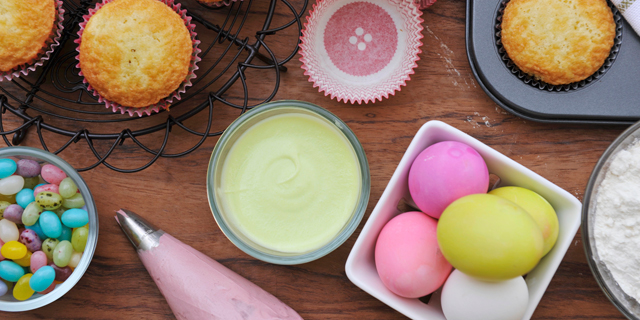Kids and parents alike love dying Easter eggs to match the bright colors of spring. But what to do with your eggs after you’ve dolled them up for the Easter Bunny? Check out our recipes and tips for hard-boiled or blown out eggs, and enjoy your creations at the kitchen table.
But before we get to cooking, a quick check on food safety. Just because those eggs are boiled, it doesn’t mean you can chop them up for a quick salad hours…. days after they’ve been hidden. Registered dietitian Carolyn Brown, a nutritionist at Foodtrainers and Qinetic, has offered up some tips on egg safety, before and after you get creative with color.
First, since you’ll want to use these eggs as more than just playful Easter pieces, consider food dye. Pick out a coloring that is safe to eat (should it seep through the shell), organic, and all natural. These options, now widely available, use vegetable juices to naturally color the eggs and are completely safe (and good for you!).
Once you’ve picked out your edible supplies, set a timer for those eggs. “You should not eat eggs that have been left out for more than two hours because that puts them at risk for salmonella,” said Brown. That means that if you want to use your eggs for Easter treats, you’ll want to boil and dye them and return them straight to the fridge. And once they’ve been hidden, make it a timed egg hunt; from start to finish, those colorful eggs should not be out more than 2 hours.
Next, what to do once the Easter egg hunt is over…
[pagebreak]You’ve found (almost) all of those eggs, now what? Get to cooking! Taking the before mentioned steps to insure egg safety, you’re ready to peel and use those eggs in new recipes.
Of course, you can use the yolks of blown out eggs for dolled up scrambled egg breakfasts; slice peeled, boiled eggs in half and whip up Latin-inspired deviled eggs; or throw slices into a savory filling for classic Argentine empanadas.
But for two new recipes, we turned to chef Brian Raczynski, pastry cook at the downtown Manhattan restaurant Juni. Raczynski was inspired by the freshness of spring and recycled his Easter eggs by using the hard boiled yolk in two traditional Latin recipes: lavendar alfajores and a quick and easy no-bake flan.
“I love how delicate these lavender alfajores are; both in texture and flavor,” said Raczynski. “The cornstarch makes them tender and crumbly, while the hard-boiled egg yolk adds to the crumbly texture, as it is not as moist as a raw yolk. The lavender is the perfect floral touch to make these alfajores a delicate spring treat!”
If you find yourself in a hurry to whip up a dessert, try Raczynski’s no-bake Spanish flan, which also uses the ready to go hard-boiled yolks.
“I love this recipe because since you are already using cooked egg yolks, there is no need to cook the flan,” he said. “It takes a classic dish and makes it so much easier to create at home, while still having that great taste we all love.”
Go ahead; load up on those Easter eggs! At TLK, we’ve got your leftovers covered.
Next, get two recipes using cooked Easter eggs!
[pagebreak]
- 3 sheets gelatin
- 1 1/4 cups milk
- 1 1/4 cups sweetened condensed milk
- 5 hard boiled eggs
- 1/2 vanilla bean, split and seeded
- 2 cups cornstarch
- 1 1/2 cups all-purpose flour plus extra for rolling
- 2 teaspoons baking powder
- 1 teaspoon baking soda
- 1/2 teaspoon fine salt
- 2/3 cup granulated sugar
- 2 tablespoons dried lavender flowers, plus extra for garnish
- 1 cup (2 sticks) unsalted butter, at room temperature
- 6 large hard-boiled egg yolks
- 1 teaspoon vanilla extract


![Making Mealtime Matter with La Familia: Easy Sofrito [Video]](https://thelatinkitchen.com/wp-content/uploads/2015/10/sofrito-shutterstock__0-500x383.jpg)
![Easy Latin Smoothies: Goji Berry Smoothie [Video]](https://thelatinkitchen.com/wp-content/uploads/2015/12/goji_berry-shutterstock_-500x383.jpg)
















![Fun and Fast Recipes: Fiesta Cabbage Salad [Video]](https://thelatinkitchen.com/wp-content/uploads/2015/11/fiesta_cabbage_slaw-shutterstock_-500x383.jpg)









